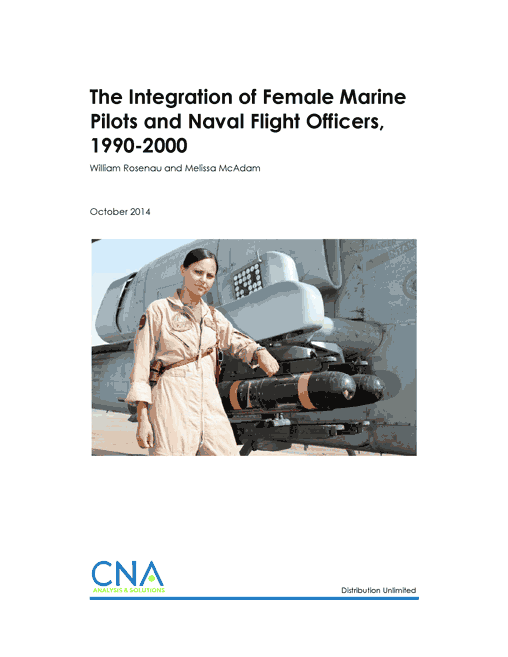As part of a broader project on the Marine Corps Force Integration Plan, the Center for Naval Analyses (CNA) was asked to examine the history of the integration of women into Marine Corps aviation. CNA gathered and analyzed primary data, including service archives, congressional testimony, and oral histories, and held discussions with a range of subject matter experts, including male and female aviators, senior military leaders, and former policymakers.
After a brief summary of the history of women in the Marine Corps, this information paper primarily focuses on the years between 1990 and 2000 and the opening of previously closed pilot and naval flight officer (NFO) occupations to female Marines. This integration was part of a decades-long evolution of the role of women in the Marine Corps and the other military services. Change was incremental and sometimes halting. By the early 1990s, ongoing social, economic, and political transformations in American society, and the performance of the thousands of women who deployed during the Persian Gulf War, created a new impetus for expanding opportunities for female Marines.
After legislative revisions and policy modifications in 1993 and 1994, women began competing for pilot and NFO training slots and, by the end of the decade, had joined helicopter, propeller, and jet squadrons. The Marine Corps adopted a low-visibility approach to the integration of women—a “quiet revolution,” as one scholar described it. The service made no broad public announcements, press coverage was minimal in the case of most women, and no particular efforts were made to prepare aviation units for the arrival of female pilots and NFOs.
Subject matter experts (SMEs) we interviewed offered a variety of perspectives on the integration experience. Both women and men described the professionalism of male aviators as well as episodes of unfair treatment and hostility within squadrons. Although generally positive about their overall experiences as aviation pioneers, most of the women highlighted the “macho” atmosphere of their squadrons, the need to prove themselves to each of their fellow officers, and the stress of being a distinct minority. At the same time, SMEs emphasized that a hard-driving, highly competitive, performance-oriented ethos was necessary to develop combat effectiveness.
This information paper does not offer any tight “lessons learned” or a template that can be applied to any formerly closed units and occupations. Clearly, a Marine infantry company differs in important ways from an aviation squadron. Instead, this paper identifies themes that the Marine Corps leadership should consider as it weighs opening ground combat occupations and assignments to women.
Some of these issues and themes have already been mentioned: the influence on the Marine Corps of the wider transformation of women in American life; the incremental nature of the expansion of career opportunities for female Marines; fears about unit cohesion; and the service’s low-key approach to integration. Marine Corps leadership also should consider the following:
- Some aviation communities, such as fixed-wing squadrons, were seen as relatively open to the presence of women, while others, such as light attack helicopter squadrons, sometimes were viewed as hostile. In the judgment of some early female aviators, the presence of men whom they knew from earlier training helped to ease their transition into squadrons.
- All of the SMEs emphasized the importance of senior squadron leadership in the integration of women. Some recalled commanders who insisted on uniform treatment and identical standards for men and women, whereas others described commands where female aviators were considered unwelcome.
Cleared for Public Release; Distribution Unlimited. Specific authority: N00014-11-D-0323.
Details
- Pages: 48
- Document Number: DRM-2014-U-008503-FINAL
- Publication Date: 10/30/2014
